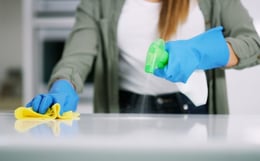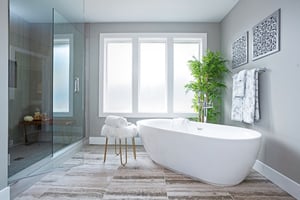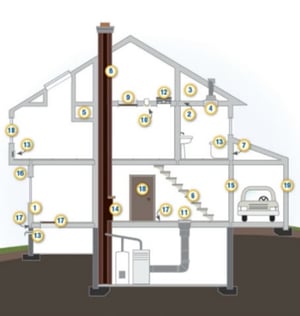With the COVID-19 outbreak people are taking cleaning and hygiene seriously. A clean home is crucial, not only for your everyday health, especially during a pandemic.
Here are a few tips for disinfecting your home and things to look for to help ensure your home has good indoor air quality*:
(*Indoor air quality (IAQ) is the air quality within and around buildings and structures. IAQ is known to affect the health, comfort and well-being of building occupants.)
1. Cleaning vs. Disinfecting
 While we often use these words interchangeably, cleaning and disinfecting have different meanings. Cleaning is the process of removing dirt, impurities, and germs from a surface, while disinfecting is the process of killing germs that are present on a surface. If you need to disinfect a surface that is dirty, first clean the item with soap and water or a mild detergent. Do not use a cleaning agent, as many active ingredients can cause harmful effects when mixed with common disinfectants like bleach.
While we often use these words interchangeably, cleaning and disinfecting have different meanings. Cleaning is the process of removing dirt, impurities, and germs from a surface, while disinfecting is the process of killing germs that are present on a surface. If you need to disinfect a surface that is dirty, first clean the item with soap and water or a mild detergent. Do not use a cleaning agent, as many active ingredients can cause harmful effects when mixed with common disinfectants like bleach.
2. Effective Cleaning Products
Not all cleaners and disinfectants are created equal. Make sure that the products you have at home are effective against whatever virus or illness you are trying to combat. The EPA has a searchable list of products that list what diseases they are effective against when used properly.

3. Soft Surfaces (Clothes, Rugs, Linens, etc.)
It’s important that you don’t overlook soft surfaces when doing a deep clean. Rugs, curtains, clothes, and bed sheets collect dirt and germs just like the other surfaces in your home and need to be routinely cleaned. The most effective method for disinfecting is to wash soft surfaces in the hottest water they can tolerate and let them dry completely before putting them back. Damp cloth can cause mildew and mold growth. For items that can’t be laundered, like carpets, use a steam cleaner with an approved disinfectant.
4. High-Use Surfaces and Items
Doorknobs, light switches, faucets, and kitchen appliances all receive daily use from almost everyone in your household. You should give them extra attention when disinfecting your home and clean them more often than other surfaces.
5. Ordering Takeout and Handling Groceries

If you're getting takeout and you're concerned about who's handling that food, the best thing to do is wash your hands before you consume the product. Take the food out of the packaging, put it on a plate, and then wash your hands before you eat.
When you're handling cardboard or plastic packaging of any kind, you can clean and sanitize counters or tables where the packaging was placed. Just be cognizant of all the surfaces that you touch and try to make sure that you're washing your hands and avoiding touching your face as much as possible.
6. Air Systems in Your Home
The three most common approaches to reducing indoor air pollution, in order of effectiveness, are: Source Control: Eliminate or control the sources of pollution; Ventilation: Dilute and exhaust pollutants through outdoor air ventilation, and. Air Cleaning: Remove pollutants through proven air cleaning methods.
New construction homes with high standards and finishing details tend to have good source control because the building envelope is sealed tight which allows less pollutants in the home for improved indoor air quality. They also include new air filtration systems and high efficiency furnaces that help move air through the home and reduce pollutants. If you're looking to upgrade your home's air systems (non-new construction homes) the EPA offers a deep dive into how to improve the air systems in your home here.

7. Indoor Plants
Plants are nature’s natural air filters. Buying a few indoor plants can do wonders to improve the indoor air quality in your home, while enhancing your home decor. Small plants like ferns and lilies (which bloom indoors) and larger palm trees are the best options to pull contaminants out of the air.
8. Check Your Building Envelope
 New construction homes incorporate extensive air sealing throughout the building envelope (this is the shell of your home including the roof, walls, floors, windows and doors). Today's building codes for new construction work hard to make sure the right pollutants stay outside your home, and the healthy airborne elements stay inside your home.
New construction homes incorporate extensive air sealing throughout the building envelope (this is the shell of your home including the roof, walls, floors, windows and doors). Today's building codes for new construction work hard to make sure the right pollutants stay outside your home, and the healthy airborne elements stay inside your home.
If you aren't living in a new construction home, you can still improve and seal any gaps in your building envelope with some quick steps. Check for air sealing around the interior and exterior of your windows, doors, and millwork that cases these openings. This is typically as simple as weather strips or caulking. On the exterior of your home, inspect and caulk/seal seams in siding and trim that may have damage to reduce the number of gaps that exist (even the really tiny ones!). Airborne pollutants might enter your home, your insulation, or your building envelope structure in even the smallest areas, and regular inspection of your building envelope is helpful.
Another bonus is reducing gaps in your structure cab also help you reduce heating and cooling costs for a more energy efficient home! Dive deeper into all the ways you can air seal your home for health, comfort and energy efficiency with further tips from the Department of Energy here.
References: